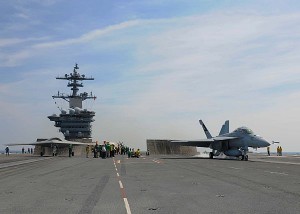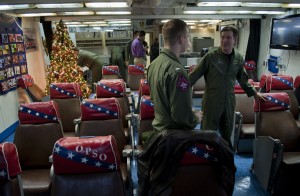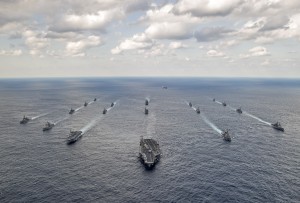 In the coming “Age of UAVs”, the influential Cold War-era Carrier Air Wing is set to become something of an old-school anachronism. Now, such sentiment is anathema to most of the exalted flyers in the leather-recliner ready-room set, but, well, the robots just don’t care.
In the coming “Age of UAVs”, the influential Cold War-era Carrier Air Wing is set to become something of an old-school anachronism. Now, such sentiment is anathema to most of the exalted flyers in the leather-recliner ready-room set, but, well, the robots just don’t care.
To a robot a deck is just a deck, and, assuming (ASSUMING) UAVs will actually get to a point they can manage the challenge of deep strike, well, as long as somebody on that deck can provide gas, ammo and maintenance, UAVs will use that deck to stay airborne, constantly moving, shuttling from carrier to carrier to base to…wherever. Robots just don’t care.
The era of the dickering over the makeup of a nicely circumscribed, well-balanced and platform-based air wing (70-some fixed-wing or rotary-wing craft serving a particular carrier) is coming to an end. Wing composition won’t matter if units are moving fluidly throughout the fleet. Yeah, sure, a few rump platform-dedicated air wings may stay on after 2030 or so, but they’ll be of the logistical services set and/or largely defensive. The great “balanced” carrier air wing of the deep strike age will be replaced (or at least supplemented) by wandering clouds of robotic locusts accustomed to spending most of their lives airborne, moving, on mission. Because, again, robots just don’t care.
Inertia is a Threat
 This transition won’t be easy. An itinerant UAV-based strike force disrupts too many long-established, well-honed careerist rice bowls. Take a look at the histrionic moaning and gnashing of teeth over the simple retirement of a redundant U.S. Navy air wing–it is only a sign of things to come. (Ok, aside from the valid risk of battle attrition, the rationale to maintain 10 air wings when two of our CVNs will be in deep, multi-year maintenance is beyond me (I’ve kvetched about that matter here).)
This transition won’t be easy. An itinerant UAV-based strike force disrupts too many long-established, well-honed careerist rice bowls. Take a look at the histrionic moaning and gnashing of teeth over the simple retirement of a redundant U.S. Navy air wing–it is only a sign of things to come. (Ok, aside from the valid risk of battle attrition, the rationale to maintain 10 air wings when two of our CVNs will be in deep, multi-year maintenance is beyond me (I’ve kvetched about that matter here).)
Change won’t come quickly if the “ten” old-school carrier air wings continue to be seen as a Congressionally-mandated “farm team” for future CVN skippers. So with Congress and a large segment of the Navy likely to argue for stasis, change will be glacial, at best.
And that puts the U.S. Navy at risk.
So carrier air wings aren’t going to go away. Sure, there will still be plenty of cozy recliner-equipped ready rooms, CAGS, and folks will still “own” the flight-deck for a long time to come, but the route to carrier command is gonna start shifting away from your conventional aviator to…something else.
The path to real air combat leadership–I suspect–will lend itself towards folks capable of putting the old carrier air wing concept aside and able to quickly grasp the battle-space. We’ll need folks (E-2D community, I’m lookin’ at you!) who can meld together a vast array of widely distributed effectors (all at different operational statuses and capabilities) into strike packages and get them to targets. But that developmental path (complicating matters, the distributed lethality pathway niche has been taken over by the–gasp!–surface warrior community) will take time–possibly too much time than the Navy really has.
The era of sending planes from discrete carriers to discrete targets (a la planes from the Midway-era Enterprise head off to strike Hiryu) is ending, and, as it does, the carrier air wing organizing concept needs to vanish along with it.
 The Carrier is little more than a FARP
The Carrier is little more than a FARP
So how do we speed things along? Well, we need to understand that Carriers are little more than logistical support bases. Flat Decks will become Floating Forward Arming and Refueling Points (FARPs), deployed primarily to service/rearm UAVs as they shuttle through their 8, 10, 12-hour (or longer!) operational cycles.
To start this transition, multi-carrier task groups need to try decoupling their air wings from their “host” carrier, with carriers supporting (really supporting) platforms from two, three or more places. Carriers (and their associated Navy Yard budgeteers, logisticians, Pentagon accountants, and so forth) need to get used to life without a dedicated wing.
But my sense is that–with more Navy money invested in old-school Ford-Class CVNs than ever–nothing will change unless either the Navy enables some youngsters to demonstrate the concept OR if some of the DC think-tanky folk start bouncing this idea around, so it gets traction in Congress and the Navy.
Now I don’t know what the talented Navy kids are doing (well, OK, some are out there studying Cyber, Space and Distributed Lethality, so it’s a start), but, as far as carriers go, the cadre of DC strategic taste-making folks haven’t pushed much beyond conventional old-school thinking–at least not yet, anyway.
CNAS’s Jerry Hendrix came close in his 2014 “Carrier Air Wing of the Future” paper, but he didn’t do much more than lob Robert Work and scamper right back to the safe (and likely far more profitable) territory of mulling F-35 numbers:
As Thomas Ehrhard and Robert Work wrote in 2008, “U.S. aircraft carriers have evolved into operational strike systems with outstanding global mobility but relatively limited tactical reach and persistence.” They argue that new types of unmanned naval strike aircraft might “spark a new carrier revolution – a revolution that could transform US aircraft carriers and their embarked air wings into key components of a persistent global surveillance-strike network effective across multiple 21st century security challenges.” Diverting savings from the F-35C program in order to accelerate the UCLASS program and field a more advanced and capable carrier-based unmanned aircraft in the 2020s would be one way to facilitate this revolution.
This is anodyne stuff–and I certainly expect more from Jerry than this. So let’s take some risks, stick our DC-ist careerist necks out and start really talking about what the UAV revolution is going to mean at a unit level in 10-20 years. It’s time for naval advocates to make some gutsy calls.
That’s how that strategy sausage starts getting made.
So my call is this: dismantling the Carrier Air Wing as an operational/organizational concept will free the Navy to develop, field and fight UAVs–and help Navy use their CVNs (and other flat decks) to the fullest.

{ 3 comments… read them below or add one }
As much as we expect the pace of change to revolutionize air warfare, I predict the carrier air wing composition will shift glacially slow and for very natural reasons unrelated to preserving ‘fly boys’.
.
First, unlike the Air Force, carrier drones will take almost as long to develop as piloted jets. Let’s walk through it. With the exception of a few helos, there is little point in using aircraft that don’t take advantage of catapult-assisted takeoffs. CATOBAR operations are ideal for maximizing payload and sparing fuel, and this largely explains why the Navy insisted on the ‘C’ version of the F-35, not the STOVL ‘B’ version.
.
So if it occupies precious space on a carrier, it might as well be a high capacity aircraft such as the UCLASS concept, not slow and small like a Predator. After all, lighter drones can be operated from smaller platforms and not crowding carrier decks. That said, a 15-ton jet-powered UAV (think X-47B, Global Hawk) will require more extensive research and development than lighter Predator-sized drones. Such larger UAVs will take more years of development to enter the carrier air wing.
.
Secondly, the economics of a strike version UAV must justify shutting down the F-35 assembly line at some point, or simply waiting until all 2,000+ F-35s are built and begin phase-out 30 years from now. Since carrier UAVs would be cat-launched and weigh 15 tons , a strike version would effectively occupy the same deck space (and CAG inventory) as a manned strike fighter. To a congressional appropriator, that smells like a call to end the F-35 production line early. The Air Force and foreign buyers of F-35s would notice a threat to its cost curve. That would prompt a pork-barrel political freak out. The UCLASS concept threatened the F-35 and now UCLASS development has been redirected toward a refueling mission. These economic and political realities suggest there will be no rush to field a jet-powered, catapult-launched strike UAV for at least 20 years.
.
Two ways this could be resolved is economics and future drone development. If a tighter budget or another F-35 setback sends its costs higher, reducing F-35 orders may create room for carrier strike UAVs. It’s also possible that future land-based UAVs may achieve long-duration flight and can remain aloft beyond 48 hours with a payload, and therefore loiter in a conflict area without burdening a carrier. Indeed it’s possible a carrier’s refueling UAV may be used to keep an Air Force UAV in theater — how’s that for a role reversal?
“It’s also possible that future land-based UAVs may achieve long-duration flight and can remain aloft beyond 48 hours with a payload, and therefore loiter in a conflict area without burdening a carrier.”
Speculation is that the overriding reason UCLASS isn’t going to be a penetrating strike or ISR system is it would be redundant, such a system is already underway or extant in the USAF.
If the only place a CVN can launch and service a drone is 1000- 2000 miles out due to A2/AD threats then the cost to service the mission from a carrier vs land becomes very questionable. Also if it already exists in the USAF in substantial numbers then there may be no good way to use the carrier based drone. Only so many stealthy planes can be over a given area or the sky becomes too crowded for the stealthy planes to maneuver around radar zones. Since the CVNs would carry very few UAVS compared to what could be cycled off land it makes little sense to put the resources into them. Lastly CVN launched drones have a distinct disadvantage in timing. Ideally, since stealthy planes have a limit in how many can be put in any area and still have room to maneuver around radar zones they need to be operated cyclically in the most efficient way. As one is leaving the forward area one is ingressing to take its place. Carrier operations are not constant, so if the timing of cyclic carrier ops don’t sync with the best cycle for the stealthy UAVS it creates gaps in coverage.
I think we will eventually find out that the overriding reason UCLASS became a nonpenetrating refueler and ISR asset is the USAF already has all the airspace available to a stealthy drone tied up, and that that airspace is pretty limited with B-2, B-21, F-35 and F-22 also needing some of it.
If the Navy put a full squadron of 12 penetrating UCLASS on each CVN that would require 132 + however many spares and training units needed. But there would only be at best 84 available at any one time as the Navy can only put max 7 carriers forward, less in a sustained campaign and its unlikely that other areas of the globe could be ignored. Its likely that it initially wouldn’t have more than the 5 it mustered for the start of Iraqi Freedom and 4 or less sustained. Thats 60 or less UCLASS in the warzone. But if the AF operates them they won’t be tied to ships with other demands. The air force would probably have to build only about 80 max to achieve the same availability and perhaps as few as 50.
The AF built 64 F-117 completely in hiding. Today their cost would have been somewhere around 14 billion. 50 drones at 200 million each = 10 billion, 80 = 16 billion.
Really when one looks at UCLASS and how its gone the shadow of a probably operational or soon to be operational USAF secret UAV looms over it.
Uh, we already do this. Any aviator who’s ever flown missions in support of a theater ATO (OEF, OND, etc) understands that carriers are just movable FARPs. The reason we have ten airwings even though we always have a carrier or two in for long maintenance is that we need to ability to send airwings in for long maintenance too. When a squadron transitions platforms, it’s not an overnight thing.
When the airwing has been reshaped into a manned-unmanned mix, the drones will probably be pooled rather than assigned to airwings ashore, but that’s not a big deal. The manned airwings will get smaller, and the unmanned units will probably be divided into a maintenance squadron which is attached directly to the ship, and a planner/controller squadron which is attached to the airwing.
What will be much more revolutionary is the fact that drones can be issued out like expensive missiles–if the ship runs low, a resupply ship can just bring more, so drone losses won’t immediately limit a carrier’s striking power. Similarly, trading airframes out mid-cruise will probably become almost routine, so that an end-of-cruise airwing has just as many “up” aircraft as they did on day one.